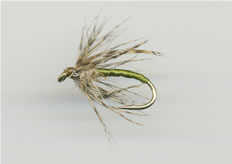Soft Hackle Wet Fly Selection
by
Eugene Macri
Soft hackle wet flies are
some of the oldest patterns in fly fishing yet these trout fly
patterns are amazingly successful. The reason that these
 trout flies are so successful is because they
imitate or suggest a variety of insects in a variety of
stages during the life cycle of the insect. Also, some of
them are also attractor patterns. trout flies are so successful is because they
imitate or suggest a variety of insects in a variety of
stages during the life cycle of the insect. Also, some of
them are also attractor patterns.
You can buy or tie soft hackles. Good hen
necks, as well grouse, wooduck, dyed mallard, guinea, and other
hackles are used. The flies are easy to tie and catch lots of
fish so. However, if you really want to learn about soft
hackles and how they are fished you would do well to take a
look at our Classic Fly
Fishing Book Library on DVD on this site. It has many of
the classic wet fly soft hackles that are so successful as well
as over 200 fly fishing books in a pdf format.
Here are some Killer Soft Hackle Patterns I
have been using for a quite a while that not too many people
know about.
The Brown Owl
Soft Hackle Pattern
- Hackle: Reddish Brown
- Body: Orange Silk (variation: orange fur)
- Head Area: Peacock Herl
The Light
WoodCock
- Hackle: From Inside of a Woodcock's wing or similar
bird (pheasant)
- Body: Orange Silk with Hare's Ear Fur towards the front
and then the orange silk.
English Blue
Partridge Modified
- Hackle: Partridge
- Body: Combination of dark bluish black fur or wool. I
ribbed this with gold wire.
The English Blue Partridge Modified is a killer fly pattern
that I used in Western PA. It catches a lot trout on some
streams. It's an especially good early season fly and probably
imitates or suggest Early Season Blue and Black Quills on some
streams. It was shown to me by some old time fly fishing
friends that would take me fishing with them when I was
young.
Summer Dun
Modified
- Hackle: Dark Brownish Hackle (from any source but
Partridge is good). Next a little bit of Blue Dun Hackle
behind this.
- Body: Yellow Silk or Yellow Fur with some mole fur or
other greyish fur dubbed behind the Blue Dun Hackle. You
can also rib the silk with wire.
This pattern gives a good contrast in the stream and can
sometimes take trout even on limestone spring creeks when
nothing else works. Tie it in very small sizes too around 18
and 20's.
These patterns and their adaptations can be found
in Yourshire Trout
Flies by Pritt which is found on the Classic Fly
Fishing Library DVD.
| 
